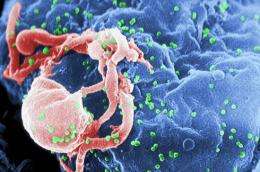More bad news in fight against persistent HIV reservoirs

July has been a particularly trying month for HIV/AIDS researchers as they mourned the loss of colleagues killed in a militant attack and received new reports of the virus' remarkable tenacity.
This week, a study published in Annals of Internal Medicine found that two HIV patients who were given "new" immune systems in the form of bone marrow transplants suffered renewed HIV infection after initially testing negative for the disease.
Publication of the study follows news this month that the so-called Mississippi baby recently tested positive for HIV. The child, who was born to an infected mother, was placed on antiretroviral drugs just 30 hours after birth and was believed to have been "functionally cured" of the disease. In reality, she had been infected all along.
In both cases, researchers pointed to the persistence of so-called latent reservoirs of the virus that remain hidden in human tissues and cannot be detected by blood tests.
"The most sobering lesson was that these cases, along with the Mississippi baby, have raised the possibility that total elimination of every last virus or infected cell to achieve lifelong remission may not be possible," wrote Sharon Lewin, an infectious disease physician and local co-chair of this year's International AIDS Conference in Australia. (Lewin commented in an editorial that accompanied the paper, but did not participate in the study.)
In the latest paper, published Monday, researchers described the cases of two men who were infected with HIV - one who was born to an infected mother and one who was exposed to the virus during sex.
They both suffered from another condition as well: Hodgkin's lymphoma, a cancer of the immune system. Because of this, they were given transplants of immune cell-producing bone marrow.
Researchers had hoped that the introduction of donor immune cells, as well as continued treatment with antiretroviral drugs, would succeed in wiping out the patients' viral reservoirs.
Reservoirs occur when the virus enters the body's CD4 white blood cells - cells that are crucial to the function of the immune system - and hide instead of reproducing. In this resting state, the virus cannot be detected, nor can it be killed by the body's immune system. However, it can later become active and begin mass producing itself, steadily eroding the body's defenses and causing AIDS.
Enthusiasm for treating HIV with bone marrow transplants was generated by the so-called second Berlin patient, who has not tested positive for HIV since 2008, when he received a similar transplant.
Unlike the patients in the latest study however, the Berlin patient received bone marrow from a donor who had an extremely rare gene mutation that conferred resistance to HIV.
Dr. Timothy Henrich, lead study author and infectious disease specialist at Harvard's Brigham and Women's Hospital, wrote that although the two men showed no evidence of the virus after the transplant, that was not the case after antiretroviral drug treatment ended.
Researchers wrote that the antiretroviral therapy, or ART, was continued for a period of years - two in one patient, four in the other - in hopes that it would help kill remaining reservoirs. During that time, the disease dropped to undetectable levels.
To see whether the men had been cured, they were removed from the drug regimen and closely monitored for the reappearance of the virus.
In one patient, the virus returned after 12 weeks; in the other it returned after 32 weeks. Once the virus was detected, the men were placed back on ART.
Although it was disappointing that the HIV returned, researchers noted that it took far longer than it usually does when drug treatment ends - about one to four weeks.
Study authors said that although donor bone marrow transplants may lead to significant, sustained reductions in the HIV-1 reservoir, the infection persists at levels that cannot be detected by current tests.
"Persistence of these small numbers of residual infected cells seems to be sufficient to rekindle HIV-1 replication," authors wrote.
©2014 Los Angeles Times
Distributed by MCT Information Services

















